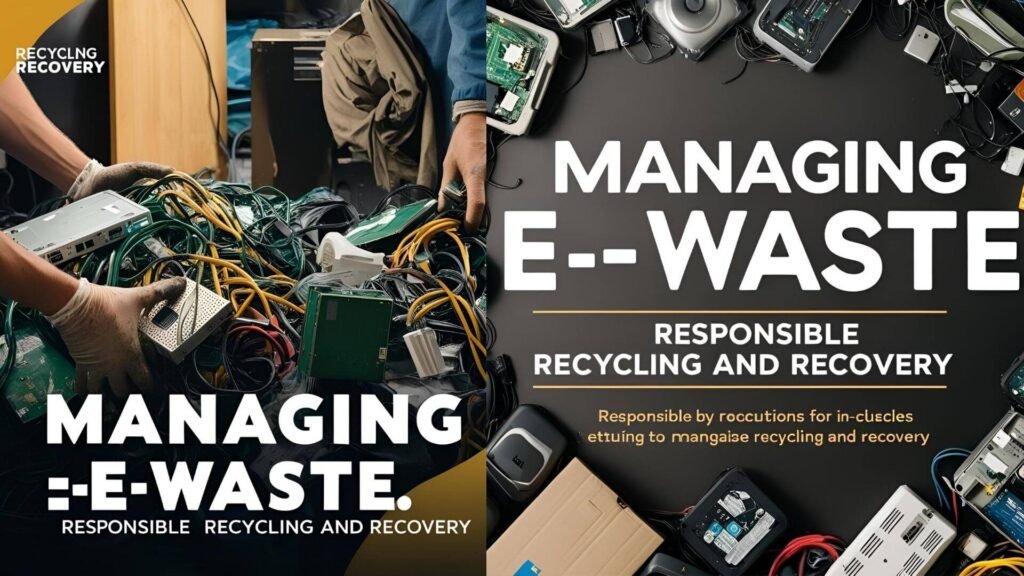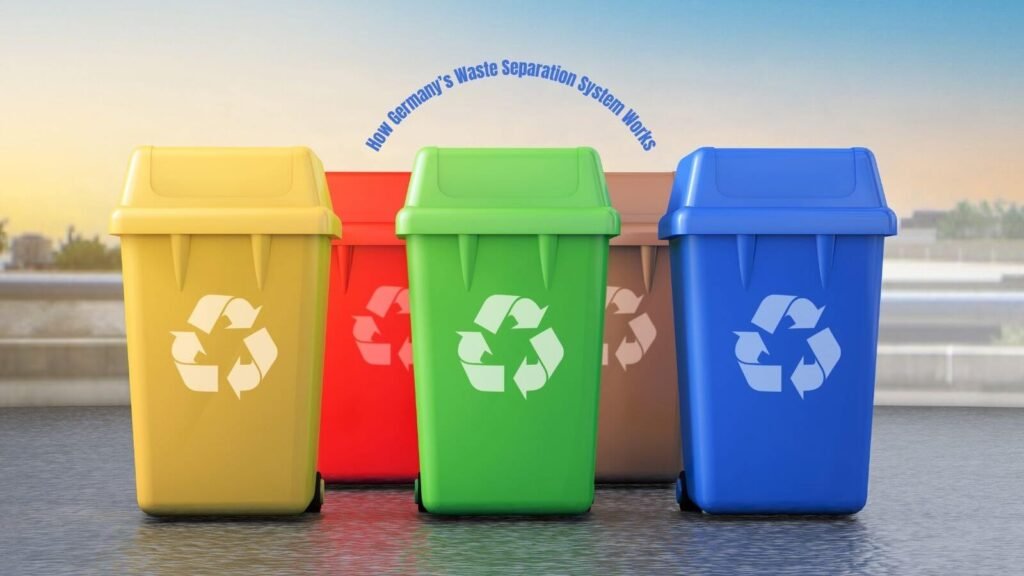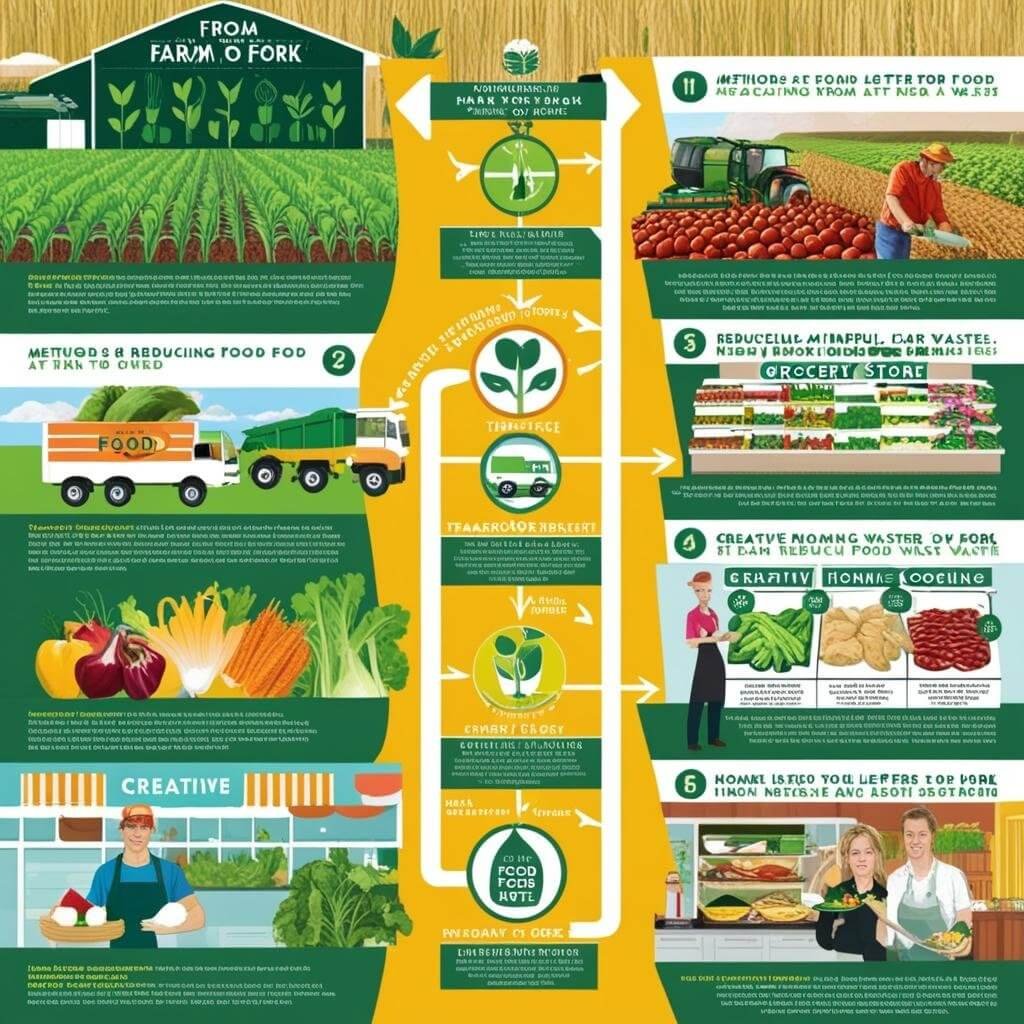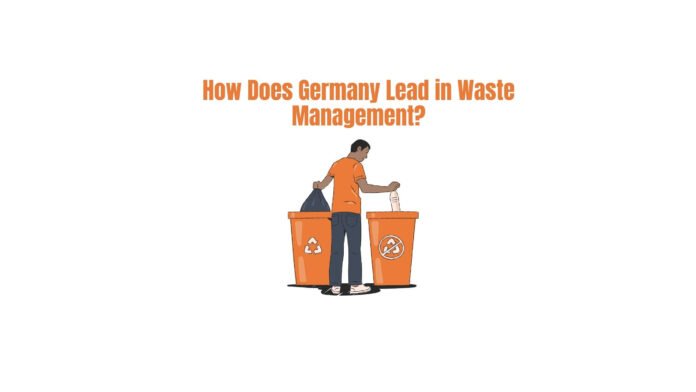Germany is one of the world’s top recyclers, with an impressive waste recycling rate of over 67%—the highest in Europe. The country has pioneered waste management strategies that have set global benchmarks. From strict waste separation to innovative plastic recycling, Germany’s approach ensures that valuable materials are recovered while reducing environmental harm.
Effective waste management in Germany is crucial in promoting sustainable waste management and a circular economy in Germany. Proper handling of food waste in Germany, e-waste recycling, and other waste streams help conserve resources, cut emissions, and keep landfills from overflowing.
This article explores Germany’s comprehensive waste management system, detailing how policies, technologies, and consumer habits contribute to its success. We’ll examine key areas such as plastic waste reduction, food waste management, e-waste recycling, and environmental policies that shape the country’s strategy.
Germany’s Comprehensive Waste Management System
Most of us sigh when sorting trash and get on with it, right? But Germany has turned this everyday chore into something truly remarkable. Thoughtfully, they’ve crafted a waste management system that’s a superstar on the global stage. You’ve probably noticed those colourful bins dotted around, and it’s not just for show. Germany doesn’t mess around when it comes to recycling. They’ve got these clear-cut policies and genuinely clever ideas that mean way less ends up in landfills. So, how do they pull it off? Let’s peek behind the curtain and see what makes their system tick.
The German Recycling System: The Kreislaufwirtschaftsgesetz (Circular Economy Act)
The Kreislaufwirtschaftsgesetz (Circular Economy Act) guides waste management in Germany. This law reduces waste, conserves resources, and promotes sustainable practices. It enforces strict rules on waste separation in Germany, ensuring the efficient processing of recyclable materials. Businesses and households must sort their waste into designated bins, promoting a circular economy in Germany where materials are reused rather than discarded.
The Waste Hierarchy: Prevention, Reuse, Recycling, and Disposal
At the heart of waste management in Germany is the waste hierarchy, which prioritizes:

- Prevention – Prioritize at the source by limiting unnecessary packaging and encouraging sustainable consumption.
- Reuse – Extending the life of products through repair, second-hand markets, and deposit return systems.
- Recycling – Converting waste into reusable materials, such as plastic recycling in Germany, has significantly reduced plastic pollution.
- Disposal is the last resort, used only when waste cannot be recycled or recovered. Germany has primarily eliminated landfill waste by using advanced waste-to-energy systems.
The Dual System and Packaging Waste Management
In Germany, manufacturers of packaging must consider its end-of-life. That’s where the ‘Dual System’ comes in. It began in 1991. 1 Companies that produce packaging pay a fee. 2 The fee depends on the wrapper’s or box’s recyclability.
The Dual System uses that money to pick up and recycle all that packaging. This system has motivated companies to use environmentally friendly packaging. They are trying to use less material and materials that people can easily recycle. They are essentially saying, ‘Hey, let’s make less trash!
The Role of Local Governments in Waste Management
Local governments organise waste separation and ensure that households and businesses comply with regulations. They oversee collection services, manage recycling laws in Germany, and run waste treatment facilities. Many municipalities also offer public education programs to help residents understand how to properly dispose of food waste, recycle e-waste, and recycle other materials.
Managing E-Waste: Responsible Recycling and Recovery

The rapid advancement of technology has caused a surge in electronic waste (e-waste), which poses significant environmental and health risks. People discard smartphones, laptops, and appliances that contain hazardous materials like lead, mercury, and cadmium. These materials can contaminate soil and water if people do not dispose of them properly. As one of the world’s largest electronics markets, Germany faces a growing e-waste challenge but has implemented strict policies to ensure responsible recycling and recovery.
Germany’s E-Waste Collection and Recycling System
Germany has a well-structured e-waste recycling system, governed by the Elektro- und Elektronikgerätegesetz (ElektroG), which aligns with the EU Waste Electrical and Electronic Equipment (WEEE) Directive. This law requires retailers and manufacturers to offer free collection points where consumers can drop off old electronics. Cities and municipalities also provide designated e-waste disposal sites, ensuring that electronic devices are properly sorted and sent for recycling.
Producer Responsibility: The Role of Manufacturers
A key component of Germany’s e-waste recycling efforts is the extended producer responsibility (EPR) model. Under ElektroG, manufacturers are legally required to finance their products’ collection, recycling, and proper disposal. This encourages companies to design electronics with longevity, repairability, and recyclability in mind, promoting a more sustainable waste management approach.
Data Security in E-Waste Recycling
Beyond environmental concerns, data security is another major aspect of e-waste recycling in Germany. Before disposing of old electronics, consumers must ensure that personal data is permanently erased. Many recycling centers offer secure data destruction services, helping individuals and businesses prevent data breaches while responsibly managing their e-waste.
The Repair Café Movement: Extending the Life of Electronics
Germany’s focus on waste reduction extends beyond recycling. The Repair Café movement, which has gained popularity nationwide, encourages people to fix broken electronics instead of discarding them. These community-driven initiatives provide tools, expert guidance, and a collaborative space where volunteers help repair damaged devices, reducing unnecessary e-waste and fostering a circular economy.
Waste Separation: The Foundation of Recycling
Germany’s waste separation system is one of the most advanced in the world. The country’s strict waste management laws require households and businesses to sort their waste to maximize recycling efficiency properly. By separating paper, glass, organic waste, plastic, and residual waste, Germany ensures that recyclable materials do not end up in landfills, significantly reducing environmental impact.
How Germany’s Waste Separation System Works
Each type of waste has its designated disposal method, supported by a color-coded bin system:
- Blue bin – Paper and cardboard
- Yellow bin – Packaging waste (plastic, aluminum, and composite materials)
- Green or white bins – Glass (sorted by color: green, brown, and clear)
- Brown bin – Organic waste (food scraps, garden waste)
- Black bin – Residual waste (non-recyclable materials)

Additionally, hazardous waste, batteries, and electronics must be taken to special collection points to prevent contamination and ensure proper disposal.
Public Awareness and Education Campaigns
Germany’s high waste separation rates are largely due to public education initiatives. Municipalities run awareness programs, schools teach waste sorting to children, and businesses are encouraged to comply with waste reduction practices. These campaigns help ensure that citizens actively participate in the German recycling system, improving overall sustainability efforts.
Challenges and Solutions in Waste Separation
Despite the system’s success, challenges remain. Some residents, particularly newcomers, struggle to understand proper waste-sorting rules, leading to contamination of recyclables. To address this, Germany is increasing digital resources, multilingual guides, and smart waste bins that provide real-time feedback on sorting accuracy.
With waste separation forming the backbone of sustainable waste management in Germany, the country continues to refine its system to maintain its position as a global leader in waste reduction.
The Circular Economy in Germany: A Vision for the Future
Germany is shifting from a linear economy, where products are made, used, and discarded, to a circular economy, where resources are reused, repaired, and recycled. This approach ensures that materials stay used for as long as possible, reducing waste and environmental impact.
Transitioning Towards a Circular Economy
The German government has introduced strict waste management regulations and incentives for businesses to adopt sustainable production methods. The focus is on designing durable, repairable, and recyclable products, ensuring that materials re-enter the production cycle rather than becoming waste.
Innovation and Technology in Achieving Circularity
Germany is leveraging advanced recycling technologies, AI-powered sorting systems, and waste-to-energy solutions to optimize resource recovery. Companies use biodegradable materials, and industries like automotive and construction are adopting closed-loop systems to minimize waste.
Environmental and Economic Benefits
A circular economy in Germany reduces carbon emissions, conserves natural resources, and creates new jobs in the recycling and repair sectors. By keeping materials in circulation, Germany lowers waste production and strengthens its economic resilience.
Future Goals and Targets
Germany aims to enhance further waste reduction efforts by increasing recycling rates, banning single-use plastics, and promoting circular business models. The country’s circular economy strategy aligns with the European Union’s Green Deal, ensuring a sustainable future where waste is no longer waste but a valuable resource.
Combating Food Waste: From Farm to Fork
Food waste is a significant challenge in Germany, affecting both the economy and the environment. However, the country has implemented strict policies and innovative solutions to address the issue, making food waste reduction in Germany a key part of its sustainable waste management strategy.

The Scale of Food Waste and Its Economic & Environmental Consequences
Germany generates around 11 million tons of food waste annually, with households accounting for nearly 59% of this waste. The substantial economic loss costs billions in wasted resources, labor, and disposal efforts. Beyond financial implications, food waste contributes to greenhouse gas emissions, as decomposing food releases methane, a potent contributor to climate change.
To combat this, Germany has set ambitious targets under its National Strategy to Reduce Food Waste, aiming to cut food waste by 50% by 2030, in line with EU and UN sustainability goals.
National Strategies and Initiatives to Reduce Food Waste
The German government has launched several campaigns to raise awareness and change consumer behavior regarding food waste. The most notable initiative is “Zu gut für die Tonne!” (“Too good for the bin!”), which:
- Educate the public about proper food storage and expiration dates.
- Provides digital tools and apps to help households reduce waste.
- Supports businesses in optimizing their food supply chains.
- Funds innovative projects that promote food waste prevention.
In addition, German laws now encourage businesses to donate surplus food rather than dispose of it.
Role of Supermarkets, Restaurants, and Households in Food Waste Reduction
Supermarkets and restaurants play a vital role in food waste reduction in Germany by:
- Dynamic Pricing Models – Discounting near-expiry food to encourage sales.
- Smart Inventory Management – Using AI to optimize ordering and avoid overstocking.
- Donations to Food Banks – Many retailers partner with Tafel Deutschland, Germany’s largest food bank network, to distribute unsold but edible food to needy people.
Households contribute significantly to food waste, often discarding food due to misinterpreting “best before” dates. Public awareness campaigns encourage consumers to use food waste reduction apps and adopt better storage practices.
Biogas Production and Composting from Food Waste
Germany efficiently repurposes food waste through biogas production and composting:
- Biogas Plants – Organic waste is processed in anaerobic digesters to produce renewable energy and organic fertilizers.
- Composting Systems – Many municipalities offer separate biowaste collection bins, ensuring that food scraps decompose naturally and enrich soil health.
These practices contribute to sustainable waste management in Germany, reducing landfill waste while generating clean energy.
Food Sharing and Food Banks
Germany has a strong culture of food sharing and redistribution, supported by organizations such as:
- Tafel Deutschland – A nationwide food bank network that distributes surplus food to low-income communities.
- Foodsharing.de – A volunteer-driven initiative that rescues food from shops, restaurants, and households and redistributes it through local collection points.
- Too Good To Go – A popular app connecting consumers with restaurants and bakeries offering discounted surplus food.
In-depth Research on Tackling Plastic Waste: Innovation and Regulation
Germany is a leader in fighting plastic waste. It has tough rules, smart recycling, and new materials. With plastic a big problem, it’s working hard to cut waste and recycle more.

1. Environmental Impact of Plastic Waste in Germany
Plastic waste poses significant environmental challenges in Germany. Despite the country’s advanced waste management, plastic litter and microplastics escape into nature. Studies have found plastic debris virtually everywhere – in rivers, soils, and the air. This persistent litter harms ecosystems: an estimated 75% of debris on ocean beaches is plastic, affecting over 800 marine species worldwide via entanglement or ingestion.
In Germany’s North and Baltic Seas, birds and marine life often ingest plastic fragments, while rivers like the Rhine show traces of microplastics in fish. These particles can carry toxic additives and enter the food chain, raising human health concerns. Plastics contain around 16,000 chemicals, with over 4,200 being persistent or hazardous. Leaching from plastic waste can produce endocrine disruptors or carcinogens, highlighting long-term health risks for humans and wildlife.
Plastic waste also contributes to climate change. Most plastics are made from fossil fuels, and their production and disposal generate greenhouse gas emissions. If plastic is incinerated (a standard disposal method in Germany), it releases CO₂ and other pollutants. Waste incinerators emit more toxins and air pollutants than landfills, which can aggravate air quality and climate impacts. Additionally, ocean plastics might affect the carbon cycle (for example, by altering plankton ecosystems or oceanic albedo).
An overview study by the Helmholtz Centre (UFZ) emphasizes that plastics are associated with the “triple planetary crisis” of pollution, biodiversity loss, and climate change. In summary, even in a regulated country like Germany, plastic waste poses multifaceted environmental threats—harming wildlife, dispersing microplastics and chemicals, and adding to climate emissions—all of which drive ongoing efforts to curb plastic pollution.
2. Plastic Recycling Infrastructure in Germany
Thanks to its extensive infrastructure for collecting, sorting, and processing waste, Germany is often lauded as a world leader in recycling. Households separate trash into multiple bins (for plastic packaging, paper, glass, organic waste, etc.), enabling efficient upstream sorting .A cornerstone is the “Green Dot” system, introduced in the 1990s, which made producers responsible for funding the collection and recycling of packaging.
Plastic packaging, such as bottles and containers, is collected through the Gelber Sack/Yellow Bin system and sent to sorting facilities. These high-tech facilities use methods like near-infrared optical sorting to separate plastics by type for recycling. However, challenges persist, with up to 50% of bin contents being improperly sorted non-recyclable or food-soiled items. Additionally, multi-layer packaging, made of mixed plastics, often cannot be processed and is typically discarded or incinerated.
After sorting, recyclable plastics are sent to reprocessors to be mechanically recycled (melted and remolded into new products). Germany’s industry also explores advanced methods like chemical recycling (breaking plastics into monomers or fuel), but mechanical recycling remains predominant. Non-recyclable plastics are usually used for energy recovery – indeed, incineration is one of the “main pillars” of waste management in Germany, generating electricity from waste. However, this comes at the cost of greenhouse emissions and is viewed as a last resort after recycling.
The Deposit Refund Scheme (Pfand) in Germany has successfully promoted recycling. Consumers pay a deposit of €0.08–€0.25 on beverage containers, refunded upon return, resulting in 98–99% return rates for single-use drink containers. As of 2015, around 93.5% of PET bottles were recycled. The system’s success is attributed to convenient reverse vending machines and meaningful deposit values. Germany continues to enhance its recycling infrastructure, including plans to include dairy drink bottles in 2024 to reduce plastic waste further.
3. Regulatory Measures for Plastic Waste Reduction
Germany’s approach to plastic waste is shaped by EU directives and national laws. The EU Single-Use Plastics Directive (2019) required member states to ban specific disposable items. As a result, Germany banned single-use plastic straws, cutlery, plates, cotton swabs, stirrers, and polystyrene food containers from July 3, 2021, eliminating 10–20% of common litter items. Additionally, under the Plastic Bags Directive and a 2019 amendment to the Packaging Act, lightweight plastic shopping bags have been banned in stores since 2022, promoting the use of reusable bags.
Nationally, Germany has enacted comprehensive waste laws. The Packaging Ordinance of 1991 (Verpackungsverordnung) introduced the Green Dot system and set recycling quotas for packaging; it was updated by the Packaging Act (Verpackungsgesetz) of 2019. The Packaging Act raised targets (e.g. requiring 63% recycling of plastics by 2022) and obliges all packaging producers to register and finance recycling. Germany also launched a “Five-Point Plan” in 2018 to reduce plastic pollution, which included measures like reducing unnecessary plastics, increasing recycling, and preventing plastic litter in organic waste.
In January 2023, a new rule – often called the “Mehrwegpflicht” – came into force: Restaurants, cafes, and takeaway businesses must offer reusable containers as an alternative for to-go food and beverages. Customers can thus opt for a reusable coffee cup or lunch box (often with a deposit) instead of disposable plastic packaging. This policy aims to shift consumers and businesses towards reusables and reduce single-use waste. Additionally, Germany recently set up a Single-Use Plastics Fund (2024) requiring manufacturers of single-use plastic products (like cigarette filters and to-go cups) to pay into a fund that covers the costs of cleaning up litter.
All these regulatory measures – from bans and levies to extended producer responsibility – have contributed to a cultural and economic push for people to reduce plastic waste at its source. For instance, early results of the single-use ban show a reduction in plastic litter; many retailers replaced plastic items with paper or bamboo alternatives, and the public has grown more aware of plastic pollution. Germany’s policies, often exceeding EU requirements, influence waste reduction and the movement toward a circular economy for plastics.
4. Innovations in Biodegradable and Alternative Plastics
Germany is investing in innovative materials to replace conventional plastics to complement reduction and recycling efforts. One area of progress is biodegradable and compostable plastics. German chemical companies like BASF have developed biopolymer materials (e.g. ecovio®, a blend of PLA and PBAT) that are certified compostable and partly bio-based. These materials can be used to make products like compostable food packaging, shopping bags, or agricultural mulch films that biodegrade under industrial composting conditions.
For example, compostable organic waste bags made of BASF’s ecoflex®/ecovio are being trialed in some German cities to improve food waste collection without plastic contamination. Such bioplastics help close the loop by breaking down into CO₂, water, and biomass in compost facilities, returning nutrients to soils rather than lingering as litter. Germany also hosts the headquarters of European Bioplastics, an industry association, and has seen a rise in startups focused on novel bio-based plastics.
A success story is the Hamburg-based startup Traceless Materials. Traceless has created a fully biodegradable plastic alternative from agricultural industry residues (like grain processing by-products). The material is processed into granules that can be formed into films, coatings, or molded items, mimicking the functionality of plastic. Importantly, it contains no synthetic polymers – it’s naturally derived and breaks down harmlessly. In 2023, Traceless secured funding to build a demonstration plant to produce several thousand tons of this material annually.
According to the company, their product could save up to 91% of CO₂ emissions and 89% of fossil energy compared to conventional plastics. This highlights the climate benefit of shifting to bio-based inputs. Other German innovators are exploring algae-based plastics, cellulose films, and enhanced recycling processes (like enzymatic breakdown of PET) to tackle plastic waste.
While promising, biodegradable and alternative plastics come with challenges. Many “compostable” plastics only biodegrade in specific conditions (e.g., in industrial composters at high temperatures) and will not decompose if littered in a cold ocean or tossed in a regular landfill. They also must be kept out of conventional plastic recycling streams to avoid contamination.
Germany is addressing this by improving labeling and separate collection for compostables. Moreover, the production of bioplastics requires agricultural resources or organic waste inputs, so scaling up must be done sustainably to avoid competing with food crops or causing deforestation. Recyclability is another consideration—some bio-based plastics (like bio-PET or PEF made from plant sugars) are designed to be recycled in existing systems, offering an alternative route to reducing fossil plastics.
In summary, Germany is at the forefront of developing eco-friendly plastic alternatives, with notable innovations in fully biodegradable materials. These alternatives have shown success in niche applications (e.g. compostable packaging for food service, biodegradable mulch films on farms) and are gradually expanding. As technology improves and costs decrease, such materials could replace a larger share of single-use plastics, reducing long-term pollution. The ongoing challenge is to ensure they are used in the right applications and properly processed at end-of-life so that “green” plastics truly deliver environmental benefits.
5. Statistics on Plastic Recycling Rates in Germany
Germany’s recycling performance is often considered exemplary, and recent statistics show high recycling rates, although the picture varies by material and how one measures it. In terms of municipal waste, Germany recycles or composts a sizable portion—by 2019, its municipal recycling rate was roughly 67%, well above the EU’s 2020 target of 50%. Focusing on plastics, the rates are lower (since plastics are more complex to recycle than glass or metal).
According to the German Environment Agency, about 46% of plastic packaging on the market was recycled in 2020 (under a new, stricter calculation method that counts only the material that genuinely enters final recycling). Updated EU data shows that Germany has continued to improve: 51% of plastic packaging waste was recycled in 2022, compared to an EU average of 41%. This puts Germany among the top performers in Europe (only a few countries like Slovakia and Belgium slightly outperform it). Germany has already met the EU’s upcoming 2025 target of 50% recycling for plastic packaging and is on track for the 55% by 2030 goal
It’s important to note what these rates include. The ~51% represents material recycling (plastic turned into new plastic products). The remainder of Germany’s plastic packaging waste is recovered chiefly for energy (incinerated with energy recovery , with very little going to landfills (Germany has effectively banned the landfilling of untreated municipal waste).
When considering all plastic waste (not just packaging), the recycling rate is lower – many durable plastics from electronics, autos, etc., end up incinerated. Germany also exports some plastic waste for recycling abroad, which raised questions about accurate recycling vs. dumping in past years. However, exports have been declining (from about 1.5 million tonnes in 2010 to ~1.0 million tonnes in 2020), partly due to stricter import bans in Asia and more domestic processing. Plastic waste exports from Germany peaked around 2010 and have declined significantly in the last decade
For comparison, Germany’s plastic packaging recycling, at 51% in 2022, is well above that of our EU peers like France (~25%) and the EU average (41%). Top performers like Slovakia (60%) and Belgium (54%) show what is achievable, but Germany remains a leader, given its size and industry. A standout statistic is the recycling rate for PET drink bottles: thanks to the deposit system, over 98% of plastic beverage bottles are returned, and most are recycled into new bottles.
On the other hand, Germany’s per-capita waste generation is high – it produces about 225–230 kg of packaging waste per person per year (all materials), one of the highest in the EU. This includes roughly 36 kilograms of plastic packaging waste per person (EU average) – and even though half of that is recycled, the sheer volume is a challenge. Meeting future targets will require maintaining high recycling rates and reducing plastic use altogether.
Germany’s example shows that strong infrastructure and policies can yield recycling rates for plastics that are among the best in the world. Yet, further efforts in waste prevention, innovation in recycling technologies, and global cooperation are essential for Germany to reduce its plastic waste’s environmental footprint.
Sources: German Environment Agency (UBA) ; Earth.Org ; Statistisches Bundesamt (Destatis) ; Eurostat ; Envirotech (Jul 2024) ; UFZ Helmholtz Centre ; Hamburg Business News .
Conclusion: A Model for the World
Germany’s success in waste management is built on strict recycling laws, waste separation practices, and a commitment to a circular economy. The country has developed a system where plastic recycling, food waste reduction, and e-waste disposal are efficiently managed, setting a global benchmark for sustainable waste management.
By enforcing waste separation regulations, promoting producer responsibility, and leveraging technological innovations, Germany continues to push toward a waste-free future. The shift toward a circular economy not only benefits the environment but also strengthens the economy by creating new jobs and reducing resource dependency.
Other nations can learn from Germany’s waste reduction strategies by implementing stricter policies, investing in recycling infrastructure, and encouraging public participation. As individuals, we can contribute by properly sorting waste, reducing consumption, and supporting sustainable products.

